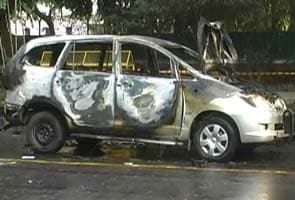
New Delhi:
As investigators search for information that could lead to who is responsible for Delhi's latest terror attack, they have little to assist them.
They believe the bomb that was stuck onto the SUV of the Israeli embassy was planted by a man on a red motorcycle. The explosion erupted on Monday evening just a few feet from the Prime Minister's house. But there was not a single security camera installed or controlled by the Delhi Police in this sensitive high security zone of the capital.
So the clue about a red bike comes from a security camera belonging to a rich entrepreneur's home on Aurangzeb Road. Home Minister P Chidambaram said yesterday that the license plate of the bike or the identity of its user is not caught on this camera.
The lack of security cameras was underscored brutally when last September a bomb exploded at a busy gate of the Delhi High Court. 11 people were killed; another 74 were injured. Judges, the police and the Delhi government had agreed that urgent course correction was needed.
Ahead of the Commonwealth Games in October 2010, Delhi had planned an extensive network of security cameras and scanners. The surveillance plans used by the London Metropolitan Police and the Beijing police had been used as a reference point. 90 entry and exit points were shortlisted for more than 2000 cameras and scanners. Control rooms at 150 locations would monitor these cameras. Each control room was to have three officers- one watching the footage, another logging it for records, and a third to organise an intervention and alert, if needed.
What exists today is shorthand for disaster in a city that has been a recurring target of terrorists. 34 markets are under surveillance; only 25 of them are monitored by the main control room of the Delhi Police. Many VIP areas have no CCTVs. Delhi's notoriously porous borders remain largely off-camera.
They believe the bomb that was stuck onto the SUV of the Israeli embassy was planted by a man on a red motorcycle. The explosion erupted on Monday evening just a few feet from the Prime Minister's house. But there was not a single security camera installed or controlled by the Delhi Police in this sensitive high security zone of the capital.
So the clue about a red bike comes from a security camera belonging to a rich entrepreneur's home on Aurangzeb Road. Home Minister P Chidambaram said yesterday that the license plate of the bike or the identity of its user is not caught on this camera.
The lack of security cameras was underscored brutally when last September a bomb exploded at a busy gate of the Delhi High Court. 11 people were killed; another 74 were injured. Judges, the police and the Delhi government had agreed that urgent course correction was needed.
Ahead of the Commonwealth Games in October 2010, Delhi had planned an extensive network of security cameras and scanners. The surveillance plans used by the London Metropolitan Police and the Beijing police had been used as a reference point. 90 entry and exit points were shortlisted for more than 2000 cameras and scanners. Control rooms at 150 locations would monitor these cameras. Each control room was to have three officers- one watching the footage, another logging it for records, and a third to organise an intervention and alert, if needed.
What exists today is shorthand for disaster in a city that has been a recurring target of terrorists. 34 markets are under surveillance; only 25 of them are monitored by the main control room of the Delhi Police. Many VIP areas have no CCTVs. Delhi's notoriously porous borders remain largely off-camera.
Track Latest News Live on NDTV.com and get news updates from India and around the world

